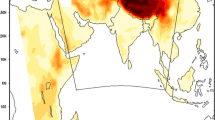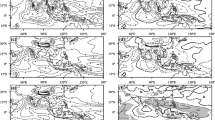Abstract
Regional climate models, such as RegCM3, generally show large biases in the simulation of western North Pacific (WNP) summer monsoon (WNPSM). In this study, the authors improved the simulation of WNPSM by applying the convection suppression criterion based on the averaged relative humidity from cloud base to cloud top. The simulated rainfall and monsoon circulation are significantly improved. The suppressed convective heating associated with the decrease in convective rainfall simulates a low-level anomalous anticyclone to its north. The anomalous anticyclone reduces the intensity of low-level southwesterly flow and the wind speed at 10 m. The reduction in wind speed at 10 m decreases the evaporation at sea surface. The less supply of water vapor from underlying ocean in turn favors less convective rainfall. The overestimation of simulated convective percentages and the cold bias of 2 m air temperature are also reduced. The different effects of convection suppression criterion in stand-alone RegCM3 and corresponding regional air–sea coupled model are also discussed.










Similar content being viewed by others
References
Arakawa A (2004) The cumulus parameterization problem: past, present, and future. J Clim 17:2493–2525
Chen H, Zhou T, Neale RB, Wu X, Zhang GJ (2010) Performance of the new NCAR CAM3.5 model in East Asian summer monsoon simulations: sensitivity to modifications of the convection scheme. J Clim 23:3657–3675
Chow KC, Chan JCL, Pal JS, Giorgi F (2006) Convection suppression criteria applied to the MIT cumulus parameterization scheme for simulating the Asian summer monsoon. Geophys Res Lett 3:L24709. doi:10.1029/2006GL028026
Dickinson RE, Henderson-Sellers A, Kennedy PJ (1993) Biosphere–atmosphere transfer scheme (BATS) version 1e as coupled to the NCAR community climate model. NCAR Tech. Note, NCAR/TN-387 + STR
Emori S, Nozawa T, Numaguti A, Uno I (2001) Importance of cumulus parameterization for precipitation simulation over East Asia in June. J Meteorol Soc Japan 79:939–947
Fritsch JM, Chappell CF (1980) Numerical prediction of convectively driven mesoscale pressure systems. Part I: convective parameterization. J Atmos Sci 37:1722–1733
Giorgi F, Marinucci MR, Bates GT (1993a) Development of a second-generation regional climate model (RegCM2). Part I: boundary-layer and radiative transfer processes. Mon Weather Rev 121:2794–2813
Giorgi F, Marinucci MR, Bates GT, Gerardo de C (1993b) Development of a second-generation regional climate model (RegCM2). Part II: convective processes and assimilation of lateral boundary conditions. Mon Weather Rev 121:2814–2832
Giorgi F, Bi X, Pal JS (2004) Mean, interannual variability and trends in a regional climate change experiment over Europe. I: present-day climate (1961–1990). Clim Dyn 22:733–756
Grell GA (1993) Prognostic evaluation of assumptions used by cumulus parameterizations. Mon Weather Rev 121:764–787
Holtslag AAM, de Bruijn EIF, Pan H-L (1990) A high resolution air mass transformation model for short-range weather forecasting. Mon Weather Rev 118:1561–1575
Huffman GJ, Adler RF, Bolvin DT, Gu G, Nelkin EJ, Bowman KP, Hong Y, Stocker EF, Wolff DB (2007) The TRMM Multi-satellite Precipitation Analysis (TMPA): quasi-global, multiyear, combined-sensor precipitation estimates at fine scales. J Hydrometeorol 8:38–55
Kanamitsu M, Ebisuzaki W, Woollen J, Yang SK, Hnilo JJ, Fiorno M, Potter GL (2002) NCEP-DOE AMIP-I Reanalysis (R-2). Bull Am Meteorol Soc 83:1631–1643
Kiehl JT, Hack JJ, Bonan GB, Boville BA, Breigleb BP, Williamson DL, Rasch PJ (1996) Description of the NCAR community climate model (CCM3), Tech. Rep. NCAR/TN-420 + STR, National Center for Atmospheric Research
Krishnamurti TN, Low-Nam S, Pasch R (1983) Cumulus parameterization and rainfall rates II. Mon Weather Rev 111:815–828
Kummerow C, Hong Y, Olson WS, Yang S, Adler RF, McCollum J, Ferraro R, Petty G, Shin DB, Wilheit TT (2001) The evolution of the Goddard Profiling Algorithm (GPROF) for rainfall estimation from passive microwave sensors. J Appl Meteorol 40:1801–1820
Liang XZ, Li L, Kunkel KE, Ting M, Wang JXL (2004) Regional climate model simulation of U.S. precipitation during 1982–2002. Part I: annual cycle. J Clim 17:3510–3529
Markowski P, Hannon C, Rasmussen E (2006) Observations of convection initiation “failure” from the 12 June 2002 IHOP development. Mon Weather Rev 134:375–405
Martinze-Castro D, da Rocha RP, Bezanilla A, Alvarez L, Fernandez JPR, Silva Y, Arritt R (2006) Sensitivity studies of the RegCM3 simulation of summer precipitation, temperature and local wind field in the Caribbean Region. Theor Appl Climatol 86:5–22
Pal JS, Small EE, Eltahir EAB (2000) Simulation of regional-scale water and energy budgets: representation of subgrid cloud and precipitation processes within RegCM. J Geophys Res 105:29579–29594
Pal JS, Giorgi F, Bi X, Elguindi N, Solmon F, Rauscher SA, Gao X, Francisco R, Zakey A, Winter J, Ashfaq M, Syed FS, Sloan LC, Bell JL, Diffenbaugh NS, Karmacharya J, Konare A, Martinez D, da Rocha RP, Steiner AL (2007) Regional climate modeling for the developing world: the ICTP RegCM3 and RegCNET. Bull Am Meteorol Soc 88:1395–1409
Reboita MS, Rocha RP, Ambrizzi T, Caetano E (2010) An assessment of the latent heat and sensible heat flux on the simulated regional climate over southwestern South Atlantic Ocean. Clim Dyn 34:873–889
Reynolds RW, Rayner NA, Smith TM, Stokes DC, Wang W (2002) An improved in situ and satellite SST analysis for climate. J Clim 15:1609–1625
Sampe T, Xie SP (2010) Large-scale dynamics of the Meiyu–Baiu rain band: environmental forcing by the westerly jet. J Clim 23:113–134
Wang YQ, Sen OL, Wang B (2003) A highly resolved regional climate model (IPRC-RegCM) and its simulation of the 1998 severe precipitation event over China. Part I: model description and verification of simulation. J Clim 16:1721–1738
Yu L, Jin X, Weller R (2008) Multidecade global flux datasets from the objectively analyzed air–sea fluxes (OAFlux) project: latent and sensible heat fluxes, ocean evaporation, and related surface meteorological variables. Tech. Rep. OA-2008-01, Woods Hole Oceanographic Institution
Zeng XB, Zhao M, Dickinson RE (1998) Intercomparison of bulk aerodynamic algorithms for the computation of sea surface fluxes using TOGA COARE and TAO data. J Clim 11:2628–2644
Zhang DF, Gao XJ, Zhao ZC, Pal JS, Giorgi F (2007) Simulation of the atmospheric circulation over East Asia and climate in China by RegCM3. J Tropical Meteorol 23:444–452 (in Chinese)
Zou L, Zhou T (2011) Sensitivity of a regional ocean-atmosphere coupled model to convection parameterization over western North Pacific. J Geophys Res 116:D18106. doi:10.1029/2011JD015844
Acknowledgments
The helpful comments from two anonymous reviewers are highly appreciated. This work is jointly supported by National Natural Science Foundation of China (41205080, 41023002), National Program on Key Basic Research Project of China (2010CB951904, 2013CB956204), China R&D Special Fund for Public Welfare Industry (meteorology) (GYHY201306019), and Public Science and Technology Research Funds (Projects of Ocean No. 201105019-3).
Author information
Authors and Affiliations
Corresponding author
Additional information
Responsible editor: S. Hong.
Rights and permissions
About this article
Cite this article
Zou, L., Zhou, T. Improve the simulation of western North Pacific summer monsoon in RegCM3 by suppressing convection. Meteorol Atmos Phys 121, 29–38 (2013). https://doi.org/10.1007/s00703-013-0255-7
Received:
Accepted:
Published:
Issue Date:
DOI: https://doi.org/10.1007/s00703-013-0255-7




